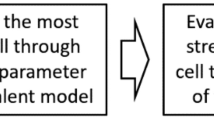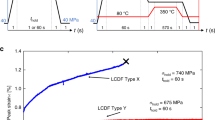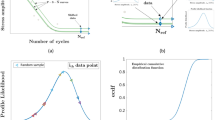Abstract
The statistical nature of failures of components subjected to fatigue loading is a major challenge in engineering applications. Here, we report an interesting fatigue phenomenon in which there is a 'duality' of the S–N fatigue data (S is stress and N is cycles to failure)—the grouping of data into two distinct S–N curves as a result of two competing failure modes. The proportions of failure by either mode are about the same and one cannot predict which failure mode will eventually dominate. This means that fatigue lives may be unpredictable in materials under certain application conditions and the consequences can be disastrous. Based on Poisson defect statistics and Monte Carlo simulations, we show that this phenomenon can arise from the Poisson distribution of low populations of microscale defects. An unexpected finding is that there should be a combination of average defect density and specimen area at which this phenomenon is observable in materials having sparsely populated defects.
This is a preview of subscription content, access via your institution
Access options
Subscribe to this journal
Receive 12 print issues and online access
$259.00 per year
only $21.58 per issue
Buy this article
- Purchase on SpringerLink
- Instant access to full article PDF
Prices may be subject to local taxes which are calculated during checkout






Similar content being viewed by others
References
Freudenthal, A. M. The statistical aspect of fatigue of materials. Proc. R. Soc. A 187, 416–429 (1946).
Weibull, W. A. Statistical representation of fatigue failures in solids. Trans. R. Inst. Technol. 27, 1–50 (1949).
Jha, S. K. & Ravi Chandran, K. S. An unusual fatigue phenomenon: duality of the S–N fatigue curve in the beta titanium alloy Ti-10V-2Fe-3Al. Scripta Mater. 48, 1207–1212 (2003).
Murakami, Y., Yokoyama, N. N. & Nagata, J. Mechanism of fatigue failure in ultralong life regime. Fatigue Fract. Eng. Mater. Struct. 25, 735–746 (2002).
Shiozawa, K. & Lu, L. Very high-cycle fatigue behavior of shot peened high-carbon-chromium bearing steel. Fatigue Fract. Eng. Mater. Struct. 25, 813–822 (2002).
Shamblen, C. E. & Chang, D. R. Effect of inclusions on LCF life of HIP plus heat treated powder metal Rene'95. Metall. Trans. 16B, 775–784 (1985).
Cashman, G. T. A Model for Competing Failure Modes in Strain Cycle Fatigue Thesis, Univ. Drayton, USA (2000).
Lutjering G. & Williams, J. C. Titanium 379 (Springer, New York, 2003).
Wiencek, K. & Hougardy, H. Description of the homogeneity of particle arrangement. Acta Stereol. 6/1, 69–74 (1987).
Neal, D. F. & Blenkinsop, J. Internal fatigue origins in α–β titanium alloys. Acta Metall. 24, 59–63 (1976).
Evans, W. J. in Strength of Metals and Alloys: Proc. Eighth International Conference on the Strength of Metals and Alloys Vol. 1 (eds Kettunen, P. O., Lepisto, T. K. & Lehtonen, M. E.) 659–664 (Pergamon, Oxford, 1988).
Atrens, A., Hoffelner, W., Duerig, T. W. & Allison, J. E. Subsurface crack initiation in high cycle fatigue in Ti6Al4V and in a typical martensitic steel. Scripta Metall. 17, 601–606 (1983).
Tokaji, K., Ohya, K. & Kariya, K. Subsurface fatigue crack initiation in beta titanium alloys. Fatigue Fract. Eng. Mater. Struct. 23, 759–767 (2000).
Hyzak, J. M. & Bernstein, I. M. The effect of defects on the fatigue crack initiation process in two P/M superalloys: Part II surface-subsurface transition. Metall. Trans. 13A, 45–52 (1982).
Tokaji, K., Ko, H. N., Nakajima, M. & Itoga, H. Effects of humidity on crack initiation mechanism and the associated S–N characteristics in very high strength steels. Mater. Sci. Eng. A345, 197–206 (2003).
Pineau, A. in Proc. Conf. on High Temperature Materials for Power Engineering 913–934 (Kluwer Academic, 1990).
Hammersley, J. M. in Proc. Symp. on Statistical and Probabilistic Problems in Metallurgy. Special Supplement to Advances in Applied Probability 47–68 (ed. Nicholson, W. L.) (Applied Probability Trust, Haifa, Israel,1972).
Montgomery, D. C., Runger, G. C. & Hubele, N. F. Engineering Statistics 100–102 (Wiley, New York, 2001).
Evans, W. J. in Encyclopedia of Materials: Science and Technology Vol. 2 (eds Buschow, K. H. J. et al.) 1829–1836 (Elsevier, Oxford, 2001).
Tokaji, K., Ho, H. N., Nakajima, M. & Itoga, H. Effects of humidity on crack initiation mechanism and associated S–N characteristics in very high strength steels. Mater. Sci. Eng. A 345, 197–206 (2003).
Fishman, G. S. Monte Carlo: Concepts, Algorithms and Applications (Springer, New York, 1996).
Ripley, B. D. Modeling spatial patterns. J. R. Statist. Soc. B 39, 171–212 (1977).
Stapper, C. H. Correlation analysis of particle clusters on integrated circuit wafers. IBM J. Res. Develop. 31, 641–649 (1987).
Lewis, P. A. W. & Shedler, G. S. Simulation of nonhomogeneous Poisson processes by thinning. Naval Res. Log. Quart. 26, 403–413 (1979).
Jha, S. K., Larsen, J. M., Rosenberger, A. M. & Hartman, G. A. Dual fatigue failure modes in Ti-6Al-2Sn-4Zr-6Mo and consequences on probabilistic life prediction. Scripta Mater. 48, 1637–1642 (2003).
Ruppen, J., Bhowal, P., Eylon, D. & McEvily, A. J. in Fatigue Mechanisms, Proc. ASTM-NBS–NSF Symposium, ASTM-STP 675 (ed. Fong, J. T.) 47–68 (ASTM International, West Conshohocken, Pennsylvania, 1979).
Jha, S. K., Larsen, J. M., Rosenberger, A. M. & Annis, C. in Proc. Minerals, Metals and Materials Soc. 2004 (MS&T, Warrendale, Pennsylvania, in the press).
Tanaka, K. & Akiniwa, Y. Fatigue crack propagation behavior derived from S–N data in very high cycle regime. Fatigue Fract. Eng. Mater. Struct. 25, 775–784 (2002).
Jha, S. K., Larsen, J. M. & Rosenberger, A. H. The role of competing mechanisms in the fatigue life variability of a nearly fully-lamellar γ-TiAl based alloy. Acta Mater. 53, 1293–1304 (2005).
Ravi Chandran, K. S., Jha, S. K. & Shankar, P. S. in Fatigue 2002: Proceedings of the Eighth International Fatigue Congress vol. 3 (ed. Blom, A. F.) 1751–1822 (Engineering Materials Advisory Services, West Midlands, UK, 2002).
Acknowledgements
This research was partly supported by AFOSR Grant: F49620-96-1-0102. C. Clay and P. M. Allen of TIMET, Henderson, Nevada, USA, supplied and helped tremendously in processing the Ti-10V-2Fe-3Al material. S. K. Jha conducted the experiments and G. T. Cashman, GE Transportation, Cincinnati, Ohio, kindly shared the data for the other materials referred to here.
Author information
Authors and Affiliations
Ethics declarations
Competing interests
The author declares no competing financial interests.
Supplementary information
Supplementary Information
Supplementary information, table S1, figures S1 and S2 (PDF 137 kb)
Rights and permissions
About this article
Cite this article
Chandran, K. Duality of fatigue failures of materials caused by Poisson defect statistics of competing failure modes. Nature Mater 4, 303–308 (2005). https://doi.org/10.1038/nmat1351
Received:
Accepted:
Published:
Issue date:
DOI: https://doi.org/10.1038/nmat1351
This article is cited by
-
Recent advances on size effect in metal fatigue under defects: a review
International Journal of Fracture (2022)
-
The Influence of Porosity on Fatigue Crack Initiation in Additively Manufactured Titanium Components
Scientific Reports (2017)



